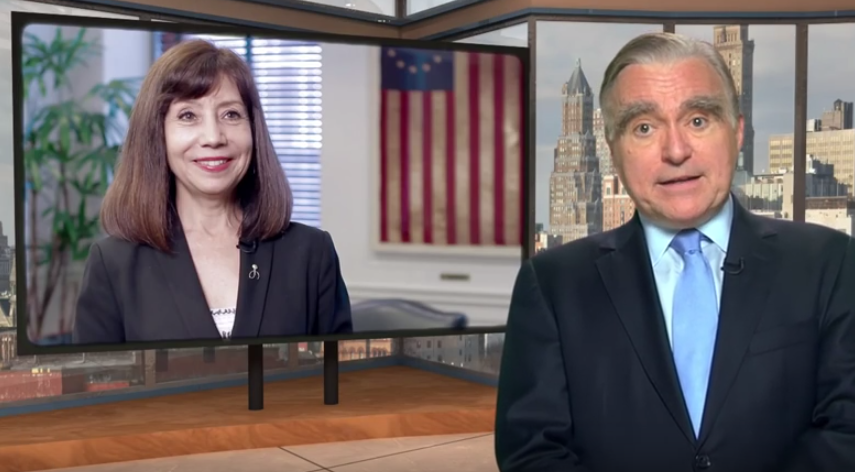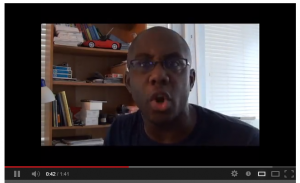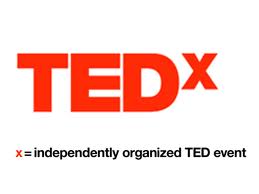You don’t have to be naturally photogenic to have on screen charisma. What you need are the skills for presenting on video.
10 Tips to Give a Knockout Video Presentation
10 Tips to Speak with a Teleprompter
I’m Not a Cat: Virtual Presentations Gone Bad
Press release: Speaking Expert, Diane DiResta Awarded Certified Virtual Presenter Designation.
NEW YORK, NY -- (June 4, 2020) -- Diane DiResta has been certified as a virtual presenter.
As the meetings industry and companies have begun working remotely, presentations and conferences have become virtual. Meeting planners want a way to identify professional speakers who can master the virtual platform.
The Certified Virtual Presenter is a new designation offered by eSpeakers. As the Internet became the way we all do business, eSpeakers provided for another need in the industry: a way for event organizers to easily find the perfect speaker, among thousands, for each audience they are responsible for. Several years later, thousands of successful speakers, trainers and coaches use eSpeakers to build their businesses and manage their calendars.
eSpeakers is the premiere spot for event planners, associations, speakers bureaus and organizations who are in search of a professional speaker.
The certification evaluates the speaker’s environment, equipment, and skills. When the speaker displays the Certified Virtual Presenter badge, it tells the world that they can expect a high quality remote experience with you, free from technical issues and with an easy-to-see and easy-to-hear presenter. eSpeakers evaluators tend to focus on specific details so that a high standard is upheld and is consistent for everyone. Presenters are assessed on their internet connection, audio quality, microphones, lighting, backdrop, screen staging and presence, eye contact, interaction, and presentation skills.
ABOUT DIANE DIRESTA
DiResta is the Founder of DiResta Communications, Inc, a New York City communication skills consultancy serving business leaders who give high stakes presentations, whether one-on-one, to a large audience, or from an electronic platform. She's the author of the amazon best selling book, Knockout Presentations. .
Tagged: virtual presentations, certification, virtual speaker
0 Likes Share
6 Tips for knockout Digital Presentations
15 Tips to Master Video Presentations
 What do today's business presenters have in common with television anchors? They both have broadcasting skills. With youtube being the number two search engine and companies demanding online learning, public speaking has gone digital. According to Business Insider 2014, “About 50 million people in the U.S. now watch video on their mobile phone." Public speakers who shun the camera will be left behind.
The first step to being a master presenter is to understand the difference between in- person speaking versus video presentations. Here are a few tips for speaking in a digital media world:
What do today's business presenters have in common with television anchors? They both have broadcasting skills. With youtube being the number two search engine and companies demanding online learning, public speaking has gone digital. According to Business Insider 2014, “About 50 million people in the U.S. now watch video on their mobile phone." Public speakers who shun the camera will be left behind.
The first step to being a master presenter is to understand the difference between in- person speaking versus video presentations. Here are a few tips for speaking in a digital media world:
- A video recorded presentation is one way communication. That means you can’t read the audience and pivot in the moment to meet their needs. So it takes a lot of preparation to deliver a compelling message and provide value to your target audience.
- In the case of teleconferencing, appoint a facilitator at each site to manage the technology and to facilitate the meeting. Be aware of delay time and plan for it by practicing longer pauses. Pause and silently count to four. That will allow enough time for the speaker to finish and for the listeners to hear the last word.
- Know the time zone of your audience. It may be 8:00 a.m. in New York, but if it’s 2:00 p.m. in Amsterdam you don’t want to start the meeting with “Good morning”.
- Display a visual agenda. People need a roadmap and it will keep the meeting or presentation focused.
- Have a back-up plan. Be able to continue by telephone if the video fails. It’s a good idea to do a test drive of the technology 15 minutes before the presentation. As a hedge, send the PowerPoint deck in advance.
- Make love to the lens. People don’t know where to look when speaking on skype. When you look directly at the caller, they see you looking down and you lose that eye connection. Try this instead: When speaking to them, look directly at the webcam. When you are listening, look at the caller.It’s uncomfortable speaking to a camera; yet that’s exactly what the presenter needs to do during webcasts and media interviews. In live presentations the presenter feeds off the audience reaction. With video, the presenter imagines the lens is a person. It’s important to maintain a steady gaze. If your eyes are darting you’ll be perceived as nervous or untrustworthy. And practice smiling and talking. Broadcasters do this easily. A serious delivery will weaken the likability factor.
- Video is an energy drain. There is an exchange of energy between a speaker and an audience. When that energy is strong, it’s palpable. That’s not the case with video. As a result, you won’t convey energy the way you do in a live performance. For that reason, you need to pump up your performance on video. In a video the presenter can easily come across as flat. Push your energy higher than normal to have the same intensity level when you’re live and in person.
- Minimize gestures. Wide, sweeping hand movements are distracting on video. Use fewer and smaller gestures. If seated, sit with both feet on the floor and lean forward at a 15 degree angle. Place both hands on the table. This is a confident speaking and listening position. You’ll be perceived as confident and it will stabilize you. Avoid excessive head nodding and jerky movements.
- You are always on stage. If someone else is speaking, chances are you are still in view. Be careful about sloppy behaviors such as slouching, looking at your phone, side talking or looking bored. The presentation isn’t over until the camera is off.
- You’ll look heavier on video. Video is two dimensional which flattens the presenter. I once was videotaping a client for a presentation. It was amazing that when I looked at her directly she appeared slim. When I looked through the camera lens she looked heavier.To manage the widening effect, dress for the camera.Remember that light colors enhance and dark colors diminish. A client of mine was unhappy with her video because she thought she looked heavy. She was wearing a boxy white jacket which gave her a wide appearance. We did a make-over. This time she wore a tapered navy blue jacket which had a slimming effect.Another way to look thinner on video is to stand at a ¾ angle with your hips back. If you’re in a close-up, drop your forehead slightly to avoid a double chin.
- Wear the right colors. White and black are not good colors for video. White creates glare. It’s better to wear off-white or pearl grey. Icy pastel colors look washed out on camera and are not a good choice. Red can bleed or look muddy. A better choice is burgundy. Avoid stripes and large bold patterns. You’ll look like a TV test pattern. When in doubt, blue is a good choice for video. It films well and psychologically blue means trustworthy, conservative, stable.
- Lighting is key. While lighting is important in a live performance, harsh lighting won’t be as damaging. On video, fluorescent lightening will highlight lines and shadows in the face and can also hurt the eyes. Use soft lighting that flatters your face.
- Choose the backdrop carefully. When doing a video presentation always ask about the backdrop. If you’re filming from home, make sure you don’t have messy papers stacked up behind you. If you’re filming off-site, choose clothing that will work with the backdrop. Early in my career I was being filmed for a speaker showcase. I asked the producer if my fuchsia suit would televise well. He said yes. Unfortunately. I asked the wrong question. I should have asked “What color is the backdrop?” When I arrived I found myself in front of an orange curtain. The fuchsia suit bled into the orange and looked terrible on film. This wouldn’t have been an issue in a live presentation.
- You cannot be boring. Engagement is crucial.You have 5-10 seconds to grab attention in a video presentation. The key to success in video presentations is good storytelling and a highly targeted audience who will appreciate the value. Being boring is deadly in any venue. A live audience will show more tolerance by listening longer. If your video presentation is boring the viewer will click off instantly. A video presentation needs to have greater engagement. A measure of engagement, is how many people watch the entire video. According to Industry standards, a 15-20% complete viewing of a 2 minute video is considered a good engagement rate. That means most viewers are not watching the complete video.
- The day of the talking head is over.To increase engagement, keep a fast pace. You need to keep the video moving. Add slides and images while you are speaking. Fly in bullet points as you speak. Keep the presentation brief. If it’s a formal speech aim for no more than 18-20 minutes. Sales presentations need to be crisp, engaging, fast moving, and brief.In my own experiment, I noticed that every time I reached for the fast forward knob, the picture would change. This happened continually as if the videographer was reading my mind. Intrigued, I started to look at the time. The frames were changing every four seconds-the same time I wanted to fast forward.
If you’re not producing video presentations you’re leaving money on the table. Your digital footprint is now an important part of your personal brand. Interviewers are asking for videos. LinkedIn now allows videos to be added to profiles. Video is the ultimate selling tool. It addresses the know, like, trust factor.
Video is not going away. To be current, you need to master video presentations.
How To Be More Media Savvy
Today’s presenters need to have broadcasting skills. I’ve been saying that for years. Even if you don’t do media interviews, you may give a presentation through videoconferencing, livestream, elearning, skype, or a webcast. There’s no avoiding it. You need to know how to present yourself on camera. Even job candidates are being interviewed through video. And if you’re speaking at a conference, you may be filmed or asked to give some comments on video.
When your 15 minutes of fame arrives will you be ready?
To learn how to shine in media, watch my interview with Employment Law Today. You’ll gain practical tips you can apply to your next video appearance.
You’ll learn:
- The biggest mistake in a media intervew
- How to handle difficult questions
- The difference between speaking to a live audience and speaking on television.
6 Periscope Presentation Tips
 Have you done your first Periscope Presentation? It's a free live stream service you can access on your smart phone or tablet.
Have you done your first Periscope Presentation? It's a free live stream service you can access on your smart phone or tablet.
If you've ever given a live stream presentation, you know that it takes a lot of work. You first go into a studio. You're dependent on the technology crew. You need to stand in the right spot. And it's expensive.
Periscope is a great tool for anyone who wants to share their presentations and live experiences. Think twitter on video steroids. Public speaking is now accessible 24/7 in real time.
Why give presentations on Periscope? It's a powerful marketing tool. Giving valuable content in real time, a public speaker can build their brand, access greater reach, engage with their audience, and speak to people from anywhere in the world-even when you're on vacation. On a personal note, imagine sharing weddings and family events with relatives who cannot attend in person. It creates a bonded community.
But as with all public speaking, you'll want to present yourself in the best light. Here are some tips for maximizing the effectiveness of Periscope or live stream presentations.
- Announce your presentation in advance. Don't think that people are going to tune in just because you popped up on their screen.Let your audience know that you'll be speaking live at a certain time and date. Send another reminder a few minutes before your broadcast.
- Prepare your opening shot. Periscope will default to the first thing the camera sees. So, point your camera to the photo or scene you want to end the broadcast. Then tap the camera to point at you if you are the public speaker.
- Engage. Start by welcoming and acknowledging the people who are watching. If you don't see any people icons, keep talking anyway. People will watch the replay. After the welcome, tell them a bit about yourself and then ask a question. Some presenters like to show the audience their venue or introduce them to their pets. People will respond in the chat box. The best presentations are dialogues.
- Provide value. Do NOT make this a sales pitch. People will not return. Give the audience some tips or discuss an issue or industry trend. Ask for their input.
- Be brief. It's better to do more frequent,, short presentations than a long session. They will get to know you over time and will look forward to your message.
- Seize the moment. If you know something is going to happen, live stream it. When I had to leave the National Speakers Association convention early, my friend live streamed the keynotes. I was so grateful. If you're going to speak, ask a friend to film you on Periscope using your phone.
For years I've been saying that future public speakers would need broadcasting skills. That time is already here. Periscope is a great presentation tool that anybody can use. The possibilities are endless.
Public Speaking Challenge: Can You Give A Speech In 6 Seconds?
 What if this happened to you? You prepare a presentation, and then the public speaker before you uses up all the time. What if you only had 6 seconds? Would you give a presentation or would you pick up your marbles and go home?
The public speaking game has changed.The digital age requires speed, brevity, and clarity. Public speakers are competing with technology. Your presentation has to be more compelling than their texts. Audience attention spans are shrinking. They're expecting 18 minute TED talks. Presentations are getting shorter and shorter, especially video presentations.
What if this happened to you? You prepare a presentation, and then the public speaker before you uses up all the time. What if you only had 6 seconds? Would you give a presentation or would you pick up your marbles and go home?
The public speaking game has changed.The digital age requires speed, brevity, and clarity. Public speakers are competing with technology. Your presentation has to be more compelling than their texts. Audience attention spans are shrinking. They're expecting 18 minute TED talks. Presentations are getting shorter and shorter, especially video presentations.
So as a public speaker, how do you present value in less time?
It's important to get to the point quickly. It's harder to give a speech in 10 minutes than in one hour. Less time requires more focus.
This month, the National Speaker's Association has their annual convention. The theme is Influence 2015. All professional speakers were challenged to submit a 6 second presentation. As a seasoned public speaker, the shortest video presentation I've given is 1 minute. So I decided to take the public speaking challenge!
Here is my 6 second presentation:
So now I'm challenging you to send me a video of your 6 second presentation. Submit the link to your video in the comments below. I'll be timing you!
Public Speaking Bloopers
 Are you a perfectionist? Get over it. It's killing your presentation. In every speech and presentation class, I tell the audience that I don't allow perfection - for two reasons:
Are you a perfectionist? Get over it. It's killing your presentation. In every speech and presentation class, I tell the audience that I don't allow perfection - for two reasons:
- You can't achieve perfection on earth so why frustrate yourself?
- Even if you could achieve it, people will resent you. Nobody likes a perfect person.
And the same is true for public speakers. Nobody can relate to a perfectly polished presenter. In fact, a public speaker who is too polished can be perceived as slick. The goal is to be human. The audience relates to your humanity, not your perfection. Yes, your presentation needs to be professional and confident. But that doesn't mean you don't trip over a word, occasionally blank out or get loud feedback noise from the microphone. It's not about a perfect presentation. It's about a confident recovery.
People who hear me speak often say, "Diane embodies her message. I learned as much by watching her on stage as I did from her content." Let me assure you that there are times when I screw up. But I make sure I recover with grace. So I'm sharing some recent bloopers as I was preparing new youtube videos. As you can see, effective public speaking and video presentations take a lot of practice. A professional video presentation requires many takes. While the finished video presentation may appear seamless, this peek behind the camera demonstrates that the process takes a lot of practice.
Now that you can see I'm not a perfect public speaker, maybe you'll stop trying to be perfect and get real!
https://www.youtube.com/watch?v=_qHuZfUOujc
8 Tips for Using Video Marketing In Your Business. Content Marketing Must Include Video.
I'm happy to have my friend, Ramon Ray, as a guest blogger. Enjoy his post about using video to market your business.
 Facebook has launched video advertising reports the Wall Street Journal. Big advertisers can place video advertisements in your news feed. Right now it’s about $2 million a day to reach all users. Guess what’s coming next? Video ads for everyone to purchase, very targeted and low cost. You already knew that video was important, now you have yet another excuse to realize how important it is. You can use video as a lead generation tool to bring traffic to your web site (or other online components). Here’s a few ways to use video in your business. Why should I know about video? Heck, I was one of the first persons to speak with President Obama in a Google Hangout – doesn’t that make me an expert? (just teasing…)
Facebook has launched video advertising reports the Wall Street Journal. Big advertisers can place video advertisements in your news feed. Right now it’s about $2 million a day to reach all users. Guess what’s coming next? Video ads for everyone to purchase, very targeted and low cost. You already knew that video was important, now you have yet another excuse to realize how important it is. You can use video as a lead generation tool to bring traffic to your web site (or other online components). Here’s a few ways to use video in your business. Why should I know about video? Heck, I was one of the first persons to speak with President Obama in a Google Hangout – doesn’t that make me an expert? (just teasing…)
- You have a smart phone. Use it to capture short, video that’s interesting to you and your customers.
- Have a smart phone that can capture good video.
- Buy a dedicated video camera like the Kodak Zii8 and use a shotgun microphone to capture better sound.
- Keep the videos short and to the point.
- Have good audio and good lighting – it is VIDEO.
- Upload to Youtube and create your own channel.
10 Presentation Trends for 2014
In 2014 presentation skills will reign supreme. Leaders and entrepreneurs will need to be more visible across different media platforms. Speaking is the new competitive advantage and the bar has been raised. Here are the trends in presentations that I predict for 2014.
- Broadcasting skills - Whether you're an entrepreneur or employed by a company, expect to have your 15 minutes of fame.Today's presenters need broadcasting skills. Media training will become a vital success skill even for those who do not speak to the press. I'm currently coaching a client to lead quarterly webcasts. Five years ago this senior executive wasn't doing any broadcasting. This client has since been filmed for executive promotional videos. Video presentations will increase in popularity. I use eyejot.com to send quick video emails. Videos can be very effective or very detrimental if you have weak presentation skills.
- Mobile presentations - Mobil technology is exploding and the number of apps is growing. This will require adjustments in the way we communicate. Slide shows and websites must be adjusted for mobile devices.The key word in presentations is portability. On a personal note, I now videotape my coaching clients on the ipad. The quality is as good as a video camera and it's easier to transport.
- Increased Need for Speaker Training - The need for excellent presentation skills will increase.due to the competitive nature of the market. Products and services can quickly become commodities and in order to be persuasive, presenters will need to know how to capture and hold the ear of the listeners.
- Self marketing presentations - Personal branding will become even more important. In a crowded market place where good jobs are at a premium. Job candidates will have to master marketing and selling. That means understanding what makes them unique and how to position themselves, their message, and their value with clarity and impact. Lack of confidence will be the deal breaker. Speakmarketing will be a growing factor for small business success. Presently, I'm coaching small businesses to develop webinars to grow their businesses.
- Storytelling - Telling stories will no longer be the domain for the talented few. Leaders will be challenged to learn the art of storytelling to develop trust, express their vision and to lead their teams. And storytelling skills will be the differentiater in the job interview.Certain companies such as Pepsico, have a culture of storytelling. The best interviewers will invest in public speaking coaching to learn to tell their story instead of presenting their resume.
- Authenticity - Audiences are more sophisticated and less tolerant than ever. They want to know who the speaker is as a person.Do they walk their talk? Audiences will value presenters who are real versus a just-the-facts approach. I was asked to coach somebody who had a well-crafted PowerPoint deck but delivered it like a talking head. Listeners are thinking "Who are you?"
- Increased Audience Interaction - The key word is connection. In a society where there is less time for socializing and more stress, people want to have an experience and participate with the speaker. Watch for increased live polling, tweeting, live streaming,and audience participation. Technology will level the playing field as speakers can now use inexpensive polling software on their mobile devices.There will also be an increase in virtual presentations. I'm coaching more clients remotely due to technology tools.
- Less Fluff More Value - Motivational speakers will always be popular as long as the human soul craves uplifting messages. But today's presenters need more than a string of 'feel good" stories. They must be able to provide value, tips, strategies, action steps, a different way of thinking along with those stories. Audiences are more demanding.
- Shorter Keynote Speeches - The 18 minute TED-like talk will become more commonplace. This is already happening at conferences. Instead of the one to three hour breakout sessions, event planners and audiences are opting for a series of shorter talks.
- Continuity - The old transactional model of giving a one hour presentation and then return to business as usual, will give way to the idea of continuity.The message will continue after the event or meeting with additional contact and add-on resources. Despite the fact that younger audiences are leaving facebook, social media will continue to be an important communication channel for staying connected. However, people will consider the return on their time and become more focused and narrow in their social media communication.
All of these trends can be summarized in one idea: Public speaking is more important than ever. The need for excellent presentation skills is not going away. It will only increase in 2014 and beyond. Just as with technology upgrades,presenters will upgrade their public speaking skills or risk becoming obsolete.
How to Get Your Message Heard
The Chinese proverb says a picture is worth a thousand words. IMAGINE how many words a video is worth.
 For years I've been saying that speakers will need broadcasting skills. Well, the future is now. Recently, I was asked to do a live stream webinar to sales teams across the country. I've also been coaching a senior executive on her internal quarterly webcasts. And I predict there will be more requests for employees and entrepreneurs to do video presentations.
For years I've been saying that speakers will need broadcasting skills. Well, the future is now. Recently, I was asked to do a live stream webinar to sales teams across the country. I've also been coaching a senior executive on her internal quarterly webcasts. And I predict there will be more requests for employees and entrepreneurs to do video presentations.
Video is a powerful medium for getting your message across.
Video use is skyrocketing.
- YouTube is the second largest search engine after Google.
- Close to 80% of people watch online videos at least once a week. (Online-publishers.org)
- Videos in emails can double the rate of response. (Getresponse.com)
- Videos are shared 12x more than links and text combined. (B2Bmarketing.net)
- Online video viewing increased by 38% between May 2011 and May 2012. (Comscore)
So we know video works. But it can work against you if you don't know how to present on camera. Here's how to get your ideas across on video:
- Keep it Brief. Don't put your entire presentation on video. Edit and display video segments.
- Speak in sound bites. It will make the editing process easier. Sound bites are memorable.
- Make an eye connection. If you are broadcasting to a remote audience, look directly at the camera. Your viewer should feel as if you're talking just to them. Have a conversation. If you are videotaping your presentation, look at your live audience.
- Light it up. You can buy a special lamp for your desk that will provide softer lighting and make you look more professional. (Harsh lighting can make you look ghastly.)
- Use a microphone. You can purchase inexpensive clip-on mics which amplify your voice and cut down on background noise.
- Content matters. Provide value for your listeners. If your content is compelling, they will want to hear what you say. Speak in terms of their self-interests.
- Let video tell your story. Video provides a consistent message to a wider audience.
Do It Yourself Marketing - Create Your Own Video Ad
June is "DIY" (Do It Yourself) Marketing Month. I've said it before and I'll say it again - today more than ever, your success depends on your ability to communicate your value to the market. There are many ways you can do this, and one of them is through online video marketing. A smart, crisp brand will help your products and services stand out from the crowd. Promoting your brand doesn't have to be expensive. Here is a free tool you can use to create a 30 second ad: animoto.com. Don't forget to create your own YouTube channel. YouTube is a high visibility, cost-effective marketing approach.
Here's the video I created for my book, Knockout Presentations:
So You Want to Give a TED Talk
 TED talks are going viral and they're raising the bar on public speaking. TED stands for technology, entertainment and design. These videos feature some of the best public speakers who are spreading the most compelling content and ideas. It's tough to be selected as a TED speaker. So on a community level, presenters are forming local events called TEDx.
Jeremy Donovan, the speaking sherpa, organized his own local TEDx event and shared his experience and secrets to being a TEDx presenter. Anybody can organize a local event. The caveat is that an organizer cannot be a speaker for the same event.
TED talks are going viral and they're raising the bar on public speaking. TED stands for technology, entertainment and design. These videos feature some of the best public speakers who are spreading the most compelling content and ideas. It's tough to be selected as a TED speaker. So on a community level, presenters are forming local events called TEDx.
Jeremy Donovan, the speaking sherpa, organized his own local TEDx event and shared his experience and secrets to being a TEDx presenter. Anybody can organize a local event. The caveat is that an organizer cannot be a speaker for the same event.
Donovan, who's been a TEDx organizer and speaker told the audience that speaking at TED is all about the story. Not every TEDx presenter is a top speaker but the one thing they all have in common is an inspiring story. He shared his formula for creating stories. Citing the movie Star Wars, Donovan deconstructed the hero's journey as a typical structure for inspirational stories. The two most important elements that are consistent in the highest rated TED presentations are storytelling and humor. He advised using humor within the first two minutes of your presentation.
While all TED talks are timed for 18 minutes, a TEDx talk can be 3 minutes, 5 minutes, or 18 minutes. Donovan gave one speaker a 5 minute slot because he wanted the audience to hear his story while protecting him from a lack of platform experience.
A big mistake first time motivational speakers make is to extol their own virtues. He warned that the audience must be able to relate and that being humble goes a long way.
How do you get selected for a TEDx talk? As in life, networking is the best way to make contact with an organizer. The interview process may require a video of your presentation as well as a marketing platform. When Donovan was an organizer, he expected presenters to have at least 500 linkedin contacts. As in publishing, the TEDx organizer needs help in promoting the event.
Can anybody be a TEDx speaker? Probably not-unless they have an inspirational idea worth spreading.
10 1/2 Ways to Keep Viewers Engaged in Your Video
 Video marketing is hot. The next best thing to face-to-face public speaking is a video. More businesses are creating video presentations because they know videos attract attention. Youtube is now the second largest search engine after google and for good reason. Video presentations are more engaging and motivational than webinars which have static slides. Video presentations make use of both visual and auditory learning styles but unlike PowerPoint, it's a lot easier to learn a skill by watching a video.
But video alone will not engage your audience. There’s a lot of competition for boring videos. Effective video marketing requires compelling content and good presentation skills.
Video marketing is hot. The next best thing to face-to-face public speaking is a video. More businesses are creating video presentations because they know videos attract attention. Youtube is now the second largest search engine after google and for good reason. Video presentations are more engaging and motivational than webinars which have static slides. Video presentations make use of both visual and auditory learning styles but unlike PowerPoint, it's a lot easier to learn a skill by watching a video.
But video alone will not engage your audience. There’s a lot of competition for boring videos. Effective video marketing requires compelling content and good presentation skills.
This video immediately engages the listener. I'm not endorsing the content or the speaker but the video serves as a good model for capturing and keeping attention. Notice how this video presentation follows all the guidelines. http://www.doubleyourfatlossnow.com/
Here are some tips to keep your audience listening and engaged to your video presentation from beginning to end.
Attract Attention with a Great Title Titles sell. Here's how to create attractive headlines:
- Use Numbers: Five Ways to Grow Your Business
- Pique Curiosity: Untold Secrets Internet Marketers Don't Want You to Know
- Ask a Question: What is your Reputation Costing You?
- Use Emotion: All Stressed Out and No One to Choke
Get Started Immediately Attentions spans are short. Make sure the video starts up when opened. Don't allow ads. Introduce yourself and get right to the point. Lengthy introductions are passe.
Get Personal People buy from people they know, like, and trust. So tell them something personal. Add a photo of yourself, possibly a family member or pet. People relate to animals and a picture of your pet humanizes you and creates a bond with the audience.
Provide A Promise What will they gain by listening to your video presentation? Provide an agenda or road map. Listeners want to know where you're taking them. A three point agenda works best.
Keep the Action Going Every Three Seconds The trend in videos is to change scenes every three seconds. Yes, three seconds! I tested this on myself. I noticed that every time I was about to fast forward a video presentation, the scene would change. I found it uncanny that this video was so tuned into my attention span. Looking for a formula, I started to count. One..two..three. The slide changed. One..two..three. The slide changed again. That's how I discovered the three second rule.
Provide Real Value Nobody will stay tuned for a sales pitch or a rambling message. Effective video marketing offers new information, and promises more data and solutions that the listener desires. Content is king on the internet as well as in videos.
Find Their Point of Pain Education for the sake of knowledge is noble but it won't sell your product, service, or brand. People need to know you understand their pain.Identify their pain points and offer relief. Your presentation must speak to them directly.
Build Anticipation In the above video, they tease the audience with the 4 hormones needed to burn fat that the medical profession doesn't talk about. Just like a good soap opera, build anticipation and people will stay tuned.
Entice with your Voice. Video presentations are a form of public speaking. If you can't afford a professional voice over, make sure you use the deeper range of your voice, articulate clearly, and keep an even pace. If your voice is not your best asset, invite a friend to do the voice over.
Don’t Add a Control Bar How many times do you try to fast forward to the end? As much as I desire a control bar as a listener, this gives the audience too much control. As long as the video provides strong content and moves quickly, you'll keep the audience listening.
Save the Offer for the Very End Avoid a sales pitch and focus on education. As you build a convincing case, people will be ready to buy. Make sure the offer happens at the very end on the last slide. Nobody likes a hard sell.
What are your tips for creating a knockout video?
Send me your links to the best videos you've watched.
Entrepreneurs "DIY" (Do It Yourself) Marketing Tips
 June is Entrepreneurs "DIY" (Do It Yourself) Marketing month. Speakers need to effectively market their speeches and presentations. Even if you work for a company, you may be called to speak at industry conferences and trade shows - and that means you need to promote yourself.
Marketing doesn't have to be expensive. Here are some free or low cost ways to promote yourself and your business.
June is Entrepreneurs "DIY" (Do It Yourself) Marketing month. Speakers need to effectively market their speeches and presentations. Even if you work for a company, you may be called to speak at industry conferences and trade shows - and that means you need to promote yourself.
Marketing doesn't have to be expensive. Here are some free or low cost ways to promote yourself and your business.
- Create a short video and post it to YouTube and social media.
- Send clients thank you cards and gifts. Send a card for FREE on me right now - creativefollowup.com.
- Promote your product in a newsletter with a large distribution.
- Use LinkedIn to find your target market. (read Jan Wallen's book: Mastering Linkedin In 7 Days Or Less).
- Use college interns to help you market.
- Post your links to google+ to get better search engine results.
- Subscribe to HARO's free media newsletter.
- Speak! Speak at local industry associations.
Marketing doesn't have to be expensive. No matter how good you are, it's not how many people you know, it's who knows you that counts. So try some of these low cost marketing tips to get your message and your name out there and make sure you know how to present yourself powerfully. When you're ready to take your presentation to the next level, click here.
How to Give a Video Testimonial
Video Marketing-The New Interview Presentation
 How do you make your job interview stand out in a crowded interview? In a previous post I blogged about a woman who was getting ready to pitch her boss for a promotion. To make her and her presentation memorable we decided to create a short video.
Why? Because I see a change in the market. Youtube.com is the number two search engine after google. Video creates that personal touch and ups the trust factor in presentation marketing. Well, now it seems that interviewers are catching on. Is the resume becoming passe? Probably not. But a video presentation can sell you better than any piece of paper. An expert can write a professional resume but nobody can speak for you. Speakmarketing is one of the most powerful ways to promote a business and create visibility inside the workplace. So it makes sense that video presentation would be the next wave in job interviews. Now more than ever before, everybody must have good presentation skills. Speaking is the new competitive weapon.
How do you make your job interview stand out in a crowded interview? In a previous post I blogged about a woman who was getting ready to pitch her boss for a promotion. To make her and her presentation memorable we decided to create a short video.
Why? Because I see a change in the market. Youtube.com is the number two search engine after google. Video creates that personal touch and ups the trust factor in presentation marketing. Well, now it seems that interviewers are catching on. Is the resume becoming passe? Probably not. But a video presentation can sell you better than any piece of paper. An expert can write a professional resume but nobody can speak for you. Speakmarketing is one of the most powerful ways to promote a business and create visibility inside the workplace. So it makes sense that video presentation would be the next wave in job interviews. Now more than ever before, everybody must have good presentation skills. Speaking is the new competitive weapon.
Read this WSJ article about the impact of digital media.
http://online.wsj.com/article/SB10001424052970203750404577173031991814896.html?mod=googlenews_wsj





